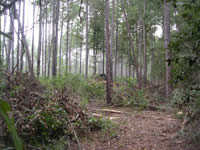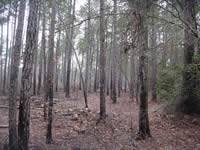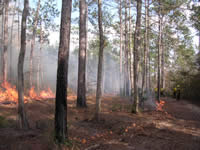
National Fire Plan Success Story
Mechanical Treatments Reduce Hazard Fuel Loads
Big Thicket National Preserve, Texas
National Fire Plan - Fuels Reduction
2008

Hickory Creek Unit before mechanical thinning.

Hickory Creek Unit after mechanical thinning.

The flames on the left side of this image are burning through an untreated area. The flames on the right side of the image are burning through a treated area.
Credits: NPS photos.
Mechanical thinning is important, especially in wildland-urban interface areas where dense continuous fuels have the potential to carry wildfires into communities. Mechanical fuels reduction helps slow the spread of wildfires, thereby decreasing the threat to nearby homes. Mechanical treatments also significantly reduce the labor costs on prescribed fires by reducing the necessary number holding resources. Mechanical equipment used at Big Thicket National Preserve is fast, treating on average three to five acres per day. It can also be very effective in thinning extremely dense areas, providing immediate fuel breaks. Compared to other heavy equipment such as a bulldozer, low ground pressure tracked machines like the Gyro-Trac or Posi-Track minimize ground disturbance. The small size and maneuverability of the equipment enables skilled operators to thin areas once too dense to even crawl through, while leaving select trees standing.
Big Thicket National Preserve has been using mechanical fuel treatments to reduce hazardous fuels in the wildland-urban interface since 2004. The majority of work is being completed in the Hickory Creek area of the park, to help reduce the wildfire threat to the 4,000-acre Wildwood Resort Community, where over 650 homes adjoin the western boundary of the unit. Mechanical treatments are also being used in high-risk areas in the Big Sandy Creek Unit of the preserve. Regular maintenance of fuel breaks in these areas is essential.
Hurricane Rita passed through the park on September 24, 2005. Winds over 100 mph uprooted mature trees, snapped trunks and branches, and as a result, increased hazardous fuels loads throughout the park. Mechanical treatments to minimize these fuel buildups are still ongoing.
Additionally, Big Thicket’s Gyro-Trac has been used for wildfire support and even went to Georgia in 2007 to help create fuel breaks.
Contact: Fulton Jeansonne, Fire Management Officer, (409) 283-5824 x 22.